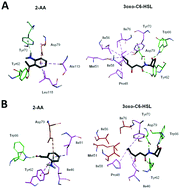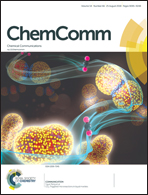A bacterial biosensor encoding a genetically modified LuxR receptor exhibits improved detection of Pseudomonas aeruginosa's biomarker molecule 2-aminoacetophenone†
Abstract
2-Aminoacetophneone (2-AA) is a volatile molecule produced in high amounts by the opportunistic pathogen Pseudomonas aeruginosa. We have previously shown that 2-AA activates the quorum sensing (QS) LuxR receptor of Aliivibrio fischeri. In the present study we were able to improve LuxR's affinity and detection limit for 2-AA by genetic modification of three amino acids within the binding pocket of the receptor. Expression of the modified LuxR receptor in a luminescent bacterial biosensor provided an efficient detection assay of 2-AA in clinical P. aeruginosa strains isolated from blood and lung infections, as well as in phlegm samples obtained from subjects suffering from lung infections.



 Please wait while we load your content...
Please wait while we load your content...